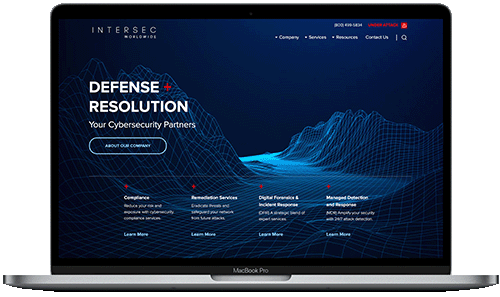DFIR: Digital Forensics and Incident Response
Finding your organization in the center of a cyber attack can be highly distressing. Whether the incident affects internal systems, external applications, or customer data, a cyber attack can result in downtime, financial losses, and a damaged reputation.
Thankfully, you don’t have to deal with the situation alone. Intersec Worldwide offers comprehensive Digital Forensics and Incident Response (DFIR) services to assist your organization through any cyber crisis. Our refined processes involve identifying, investigating, and remediating attacks so that you can have peace of mind and focus on running your business.
DFIR Services
Digital
Forensics
We use advanced tools and techniques to investigate incidents thoroughly and mitigate future threats.
Data Breach Response / Incident Response
Our incident response team takes swift action to solve issues and get your operation back on track.
Ransomware
Recovery
We implement the best possible protection system against ransomware attacks to help you avoid and overcome these potentially crippling attacks.
(PFI) PCI Forensics Investigator
Our PFI services are deployed in case of cardholder data compromise to determine the root cause and remediate issues.
Compromise Assessment Services
We run a full compromise assessment to identify digital attacks and verify their presence.
E-Discovery
Services
Our e-Discovery services securely capture, process, and analyze data and deliver it in a format that can be presented as evidence.
Incident Response & Breach Remediation
Defeat cyber threats and fix the vulnerabilities that left you exposed in the first place with our incident response remediation services.

What is DFIR?
What is digital forensics and incident response? The digital forensics process can be compared to an archeological dig on digital devices for historical artifacts. It involves thorough analysis on items such as computers, tablets, smartphones, flash drives, and hard drives, and more, with the goal of producing data artifacts that explain both the cause of a digital compromise and the impact to your organization.
When you initiate DFIR or digital forensics services, it’s important that forensically sound methods of analysis are used. At Intersec, we use specialized data recovery techniques and principles and follow guidelines and practices required if the evidence is to be legally viable to stand up in a court of law or withstand a challenge during an insurance claim. Our approach to DFIR services is unique.
The incident response component of DFIR refers to the fact that forensics are typically performed in reaction to a cyber incident.
Ultimately, the goal of digital forensics and incident repsonse is to identify, recover, preserve, and analyze pertinent data and present findings, including both facts and opinions. Whether it’s a recently uncovered ongoing issue or a cyber emergency, a digital forensics and incident response team can jump in to determine the cause of the issue and provide remediation solutions.

What Sets Intersec Apart From the Competition in DFIR?
Digital forensics and incident response / DFIR cybersecurity services are a blend of two separate trade crafts: digital forensics and incident response. At Intersec, we are forensic experts and incident response experts. While some agencies specialize in one or the other, Intersec blends both within its model and knowledge base.
Relying on incident response alone may be a band-aid solution for the problem, as it often doesn’t impact the root cause in order to prevent future attacks. As incident responders dig into an ongoing incident, they reach a point where they need additional analysis performed or a forensic model built.
The forensics component requires that we also dive deep into historical data, using intense examination to gather data and find the cause. This is particularly important in the many cases where legal action will be taken. An organization needs to be able to provide solid evidence of the attack.
The Value of Integrated Digital Forensics and Incident Response
While digital forensics can be separated from incident response, it’s far more practical and productive to have the two combined.
From a practical perspective, splitting the two activities between different firms would require multiple NDAs and legal agreements, and collaboration between the two teams would be logistically difficult. By combining both in a full-service package, teams work within a single project. It also means that gathered evidence will be reliably comprehensive and viable.
DFIR provides a faster, more effective process that sees security situations investigated thoroughly and remediated quickly.
How is Digital Forensics Used in the Incident Response Plan?
Digital forensics is a crucial part of any incident response plan. Without discovering the cause and methods behind an incident, response teams are only doing half a job. Utilizing digital forensics has multiple benefits, including enabling you to determine the cause of the incident and reliably identify the scope and impact.
A full investigation also avoids the trap of overlooking key information that may lead to future attacks. Using digital forensics will ensure we discover all vulnerabilities that led to an attack or error. Our forensic incident response team is then equipped to remediate the situation as efficiently as possible.

What Capabilities are Common in DFIR?
Intersec Worldwide delivers a broad range of DFIR capabilities as opposed to specializing in just one area. Our detailed digital forensics process and incident response system include:
- Data collection from mobile devices, laptops, desktops, mainline servers, and other hardware items.
- Complete monitoring of network nodes such as firewalls and intrusion detection devices.
- A fully transparent system in which all actions and processes are clear.
- Thorough and compliant investigation and analysis.
- Isolation, quarantine, and review of any compromised systems.
- Comprehensive and clear incident reports.
How to Choose a DFIR Service Provider
One key thing to look out for is a provider that has vast experience in both areas.
Because of the legal aspect involved in DFIR, it’s crucial that you employ highly experienced professionals for the task. What’s more, providers must have the necessary tools to carry out a thorough investigation.
From the digital forensics perspective, advanced computer forensic tools are used to examine devices, disks, and other items and analyze recovered data.
DFIR can involve large projects with lots of moving parts, so it's imperative that project management is at the forefront of your provider's expertise.
Learn more about Intersec’s impressive cybersecurity experience now.